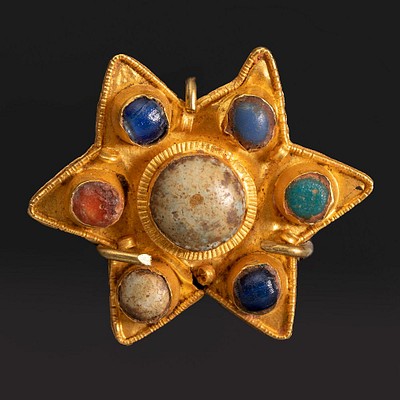RAFAEL ROMERO DE TORRES (Cordoba, 1865- 1898). "Man in profile. Oil on canvas.
Lot 115
About Seller
Setdart Auction House
Carrer Aragó 346
Barcelona
Spain
Setdart Subastas was born in 2004 and is currently the first online art auction in Spain with solidity, prestige and reliability guaranteed by our more than 60,000 users. Setdart has a young, dynamic and enterprising team ready to successfully manage the purchase and sale of art works through custom...Read more
Estimate:
EUR€6,000 - EUR€8,000
$6,382.98 - $8,510.64
Absentee vs Live bid
Two ways to bid:
- Leave a max absentee bid and the platform will bid on your behalf up to your maximum bid during the live auction.
- Bid live during the auction and your bids will be submitted real-time to the auctioneer.
Bid Increments
| Price | Bid Increment |
|---|---|
| EUR€0 | EUR€10 |
| EUR€200 | EUR€25 |
| EUR€500 | EUR€50 |
| EUR€1,000 | EUR€100 |
| EUR€3,000 | EUR€200 |
| EUR€5,000 | EUR€500 |
| EUR€10,000 | EUR€1,000 |
| EUR€20,000 | EUR€2,000 |
| EUR€50,000 | EUR€5,000 |
About Auction
By Setdart Auction House
Dec 21, 2021
Set Reminder
2021-12-21 07:30:00
2021-12-21 07:30:00
America/New_York
Bidsquare
Bidsquare : Córdoba: 2,000 Years of Art
https://www.bidsquare.com/auctions/setdart-auction-house/c-rdoba-2-000-years-of-art-8049
Setdart Auction House sofia@setdart.com
Setdart Auction House sofia@setdart.com
- Lot Description
RAFAEL ROMERO DE TORRES (Cordoba, 1865- 1898). "Man in profile. Oil on canvas. Signed in the upper left corner. Measurements: 48 x 40 cm; 64 x 55 cm (frame). Son of the painter Rafael Romero Barros. He was born in Cordoba in 1865 and died in this same city in 1898. From a very young age he would demonstrate his talent in painting. At the age of eight he entered the Provincial School of Fine Arts thanks to his father who noticed the great talent that the little boy possessed. Rafael grew up in a cultural environment among artists, artworks and the museum that his father directed. All this combined in the family compound which was decisive for his development. Due to the talent that Rafael Romero de Torres would develop over the years he was awarded with some scholarships, firstly, he was granted in 1884, by the Diputación de Córdoba, a scholarship to settle in Madrid at the Academia de San Fernando where he studied sculpture combined with painting. Here he collaborated with his brothers Enrique and Julio in the illustrations of the magazine La Gran Vía. His stay in the capital was extended due to Rafael's success with the acquisition of some prizes, but he did not stop visiting Cordoba whenever he could. All his effort and success would be reflected in the second scholarship in 1885, thanks to the painting Sin trabajo, which was granted again by the Diputación to settle in Rome for a period of three years, a period that was a key stage for his development. After these years in Italy he returned to Spain where he alternated residence between Madrid and Cordoba. Ricardo de Montis, a family acquaintance and friend of Rafael, tells how Rafael was a person with a cheerful character, graceful and fluent in socializing and with the guitar, as when he played with Gayarre, who accompanied him with his voice inside the house of the painter Madrazo. On his return from Rome, says de Montis, he began to work with great impetus and entered the National Exhibition of the time, which would change his vision and take away the hope that the Cordovan artist possessed. According to de Montis. After such an event, Rafael would produce work to cover his needs only, since his desire to grow as an artist had diminished and his illusions were more and more dead. It was at this time that he contracted an illness that cost him his life. Rafael's painting is nourished by the influences of Cordoba, Madrid and Rome, painting in which he shows a pictorial naturalism interested in history, as we see in works such as The Death of Cleopatra (Cordoba. Provincial Deputation. 1886) or Columbus leaving the Mosque (Cordoba. Museum of Fine Arts. 1892). But passing through these works of historical themes and some portraits, we will see how the painting of social character will be the personal and important of the artist. This was defined in a trilogy that perfectly defined the social theme: Without Work (Cordoba. Provincial Council. 1888), The Last Sacraments (The Wounded Bricklayer) (Cordoba. Museum of Fine Arts. 1890) and Looking for Homeland (Emigrants on Board) (Museo Nacional del Prado. 1892). Besides being a painter, it is worth mentioning his facet as a draftsman and illustrator in periodical publications of the city of Madrid and Cordoba. His skill as a painter was reflected in the use of various techniques in the drawings that are preserved in the Museum of Fine Arts of Cordoba, as well as in the well-known illustrated letters he sent to his family from Rome and Madrid, where he reflected his facet as a portraitist while also leaving architectural references.
- Shipping Info
-
In-house shipping available. Please inquire at admin@setdart.com.
-
- Buyer's Premium



 EUR
EUR CAD
CAD AUD
AUD GBP
GBP MXN
MXN HKD
HKD CNY
CNY MYR
MYR SEK
SEK SGD
SGD CHF
CHF THB
THB














